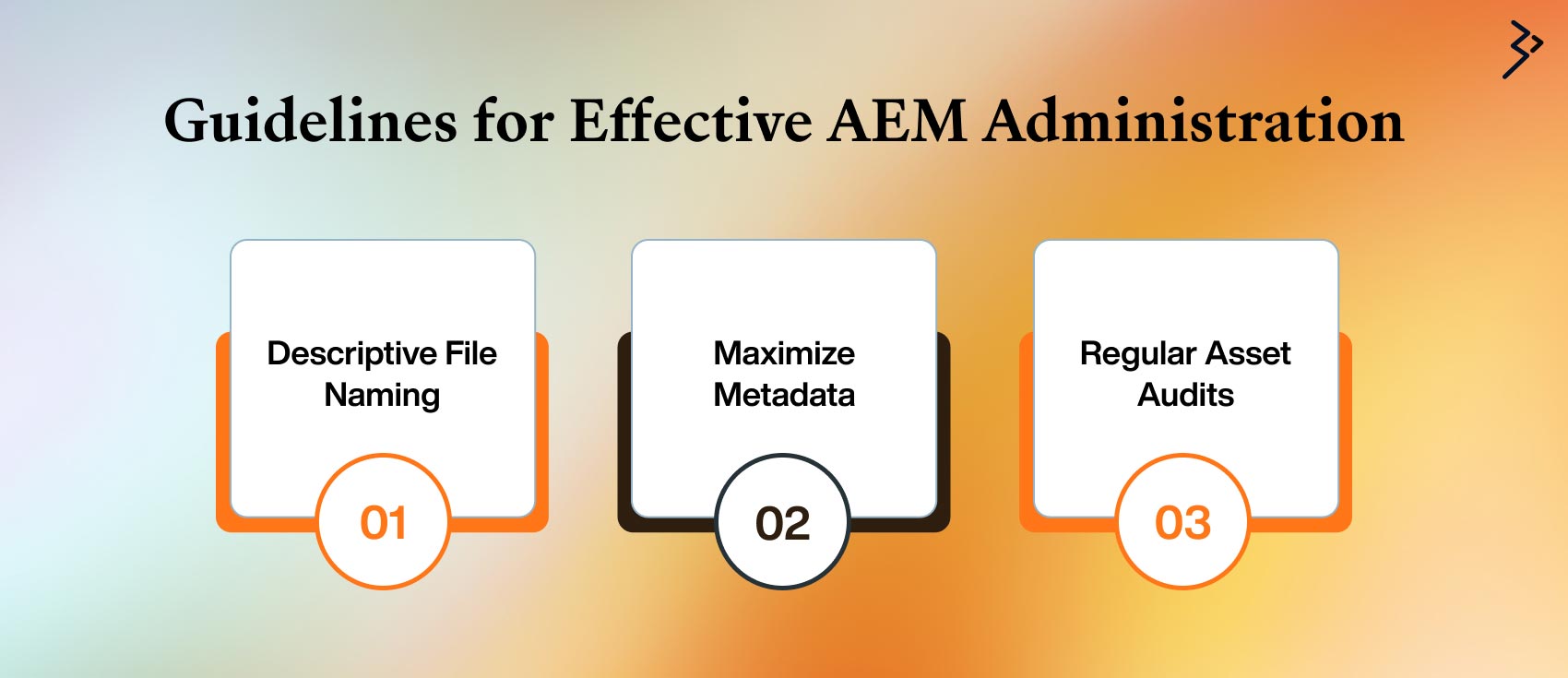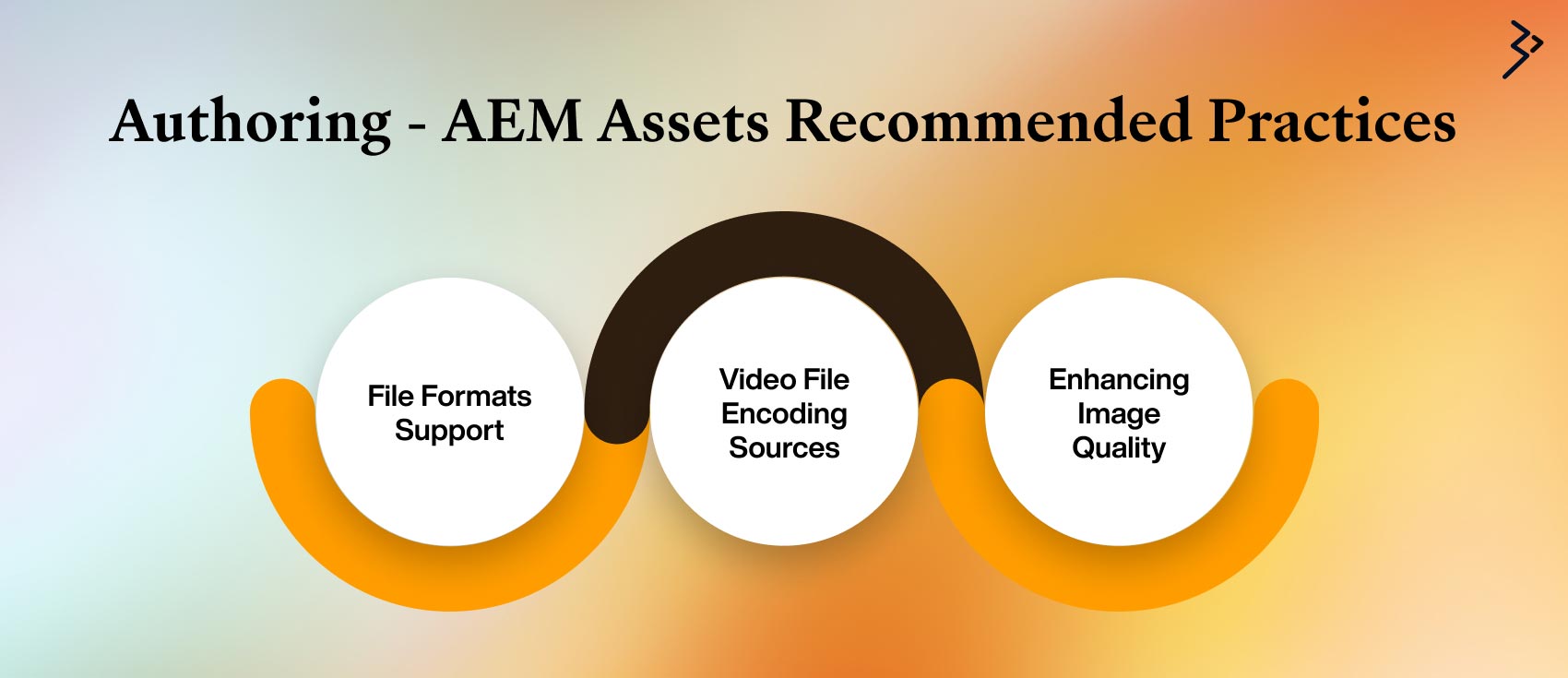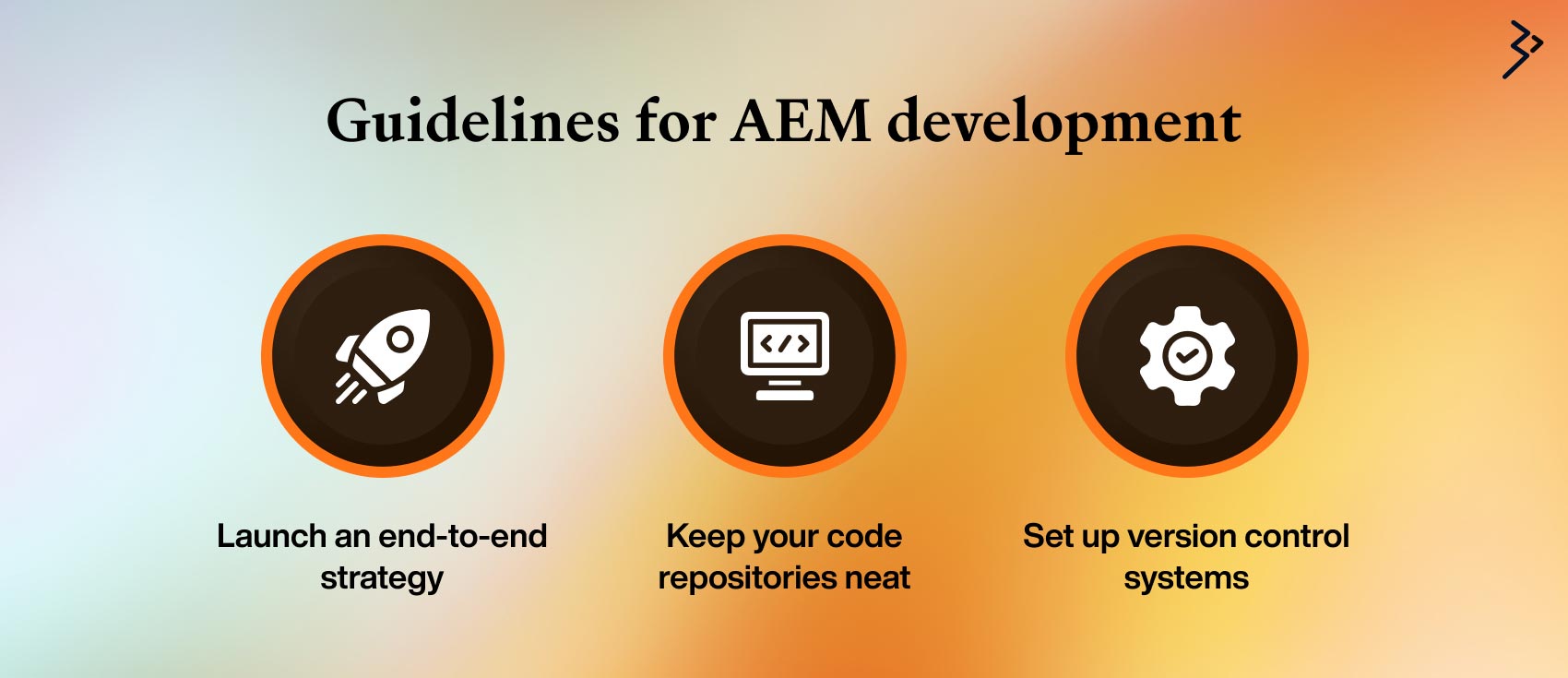Table of contents
Adobe Experience Manager–what is it?
Best Practices for Implementing AEM
Guidelines for AEM development
Guidelines for the Java Application Programming Interface (API)
Recommended Methods for Implementing AEM
Guidelines for Effective AEM Administration
Authoring - AEM Assets Recommended Practices
Wrap Up!
Adobe Experience Manager (AEM) is a premier content management solution that enables businesses to create, manage, and optimize digital experiences seamlessly. However, customer experiences have become a top priority for companies in the modern digital era. Everyone knows that "experience" is now the new product. Encouraging a smooth and satisfying user experience may significantly impact your ability to engage potential consumers, leading to higher conversion rates and more income.
You need state-of-the-art solutions, like Adobe Experience Manager (AEM), to nurture this enriching experience. This exhaustive handbook details the recommended practices of Adobe Experience Manager (AEM).
Adobe Experience Manager–what is it?
To start, let's discuss what AEM is and how to use it effectively. Essential for digital marketing services, Adobe Experience Manager (AEM) is a content management system that aids companies in creating websites, mobile applications, and forms while also improving the administration of marketing assets and information.
Thanks to AEM's expert separation of "content" and "presentation," design updates can be implemented swiftly without compromising the overall look and allowing brand consistency to stray across platforms. Included in Adobe Commerce Cloud Development Services, it equips marketers with the means to enhance user experiences by providing personalized content driven by data-driven initiatives. With the help of AI, customization options, and automation, AEM has become the go-to platform for businesses who want to grow their digital infrastructure fast.
According to Adobe, "Shoppers can register and shop without waiting," thanks to the AEM eCommerce integration. This is an interesting statistic regarding the ways in which AEM enhances user experiences. To generate conversions, it is essential to guarantee that clients have enjoyable and painless shopping experiences.
While it is essential to be familiar with AEM's features, the ideal way to use it is to follow the best practices discussed in the next section. Among other things, we can learn about AEM design best practices.
Best Practices for Implementing AEM
Taking the plunge into using Adobe Experience Manager Services (AEM)? At times, it could be perplexing to know what to do. Those first steps toward a good experience are no longer an uphill battle when you have "best practices for implementing Adobe Experience Manager" to advise you.
Identifying the needs and parameters of your particular project is a crucial first step. In this investigation, you should consider the demands of stakeholders, limitations of technology, concerns about security, and expectations of end users.
When you begin your path to install AEM, there are four essential elements that you should prioritize:
- Establishing measurable business objectives: Specify the project's success criteria. Your goals should sync with the company's overall demands to ensure a smooth journey toward mutual achievement.
- Knowing what the platform can do: Adobe Experience Manager has many features, including Sites, Assets, Campaigns, and more, so it's flexible. Gaining a grasp of these features will enable you to customize a highly effective solution tailored to your unique situation.
- Bringing team members' expertise together: An AEM project requires various skills, from design to development and maintenance. Therefore, it's essential to put together a competent team.
- Content migration & management: Since content is the backbone of any digital experience management platform, meticulous preparation is essential for categorization, transfer, and workflow establishment.
Read More: How Retail Businesses Use AEM for eCommerce and Customer Engagement
Research has shown that "effective caching tactics at the AEM dispatcher level further improve site performance and user satisfaction." This means that extra care at the start of your AEM implementation journey pays off massively, giving your users a speedy, seamless experience. When discussing AEM implementation best practices, setting up an effective caching method at the dispatcher level is another highly recommended strategic move.
These initial steps will lead you to a successful Adobe AEM deployment best practice. Every step we’ve taken so far — from creating to managing AEM components — builds toward establishing reliable best practices for AEM components.
Guidelines for AEM development
Here, we describe the creation of Adobe Experience Manager, going into depth about the AEM performance tuning that has to be considered while building the software, content, and development architecture. After that, we will look at the best practices for AEM development, strategies for integrating JCR and OSGi, and the best practices for the Java API.
Software, Content, and Development Architecture
To guarantee a strong AEM implementation, starting with the correct foundation is crucial. Some of the most important rules to follow while planning the framework of your development process are:
- Launch an end-to-end strategy: This will ensure that every part of your initiative is well-considered.
- Keep your code repositories neat: clean codes make future debugging much more manageable.
- Set up version control systems: These will help manage source code changes over time and restore earlier versions in an emergency.
When building your content architecture, ensure it can quickly adapt to various forms of multimedia without sacrificing the user experience or interface.
Standards for Coding
Following AEM coding best practices is crucial since code is the backbone of every good software development project.
- Adhere to standards: Your team's programmers should follow common practices that allow code to be easily understood and maintained.
- Implement Modularity: Modularity should be implemented by encouraging components to be constructed as separate modules. This will allow them to function independently and reduce dependencies.
There’s absolutely no denying that when you understand these coding principles, you can write code that is both efficient and easy to maintain.
Integration of JCR and OSGi
The Java Content Repository, or JCR, is a standardized mechanism for bidirectional, granular content access inside logical trees (nodes). Because of its granular security restrictions, it is a good fit for container architectures that employ component-based approaches, such as Sling Resource Resolution and OSGi (Open Service Gateway Initiative).
Integrating JCR with OSGi makes it an incredible, powerful dynamo. AEM mainly uses it for the content repository. It is the basis for constructing strong applications.
Read More: Step-by-Step Guide to Implementing Adobe Analytics in AEM
Guidelines for the Java Application Programming Interface (API)
You need to use Java API tools to build AEM effectively.
According to what the experts say:
- Use up-to-date interfaces rather than deprecated ones.
- Sling Models are preferable to WCMUse objects because they are more concise and flexible, making them easier to manage.
- Knowing how to use a session effectively manages conflicts for resources in different parts of the system.
Both inexperienced developers and seasoned pros seeking to improve their craft might gain from seeing these coding best practices implemented.
The above is an outline of the most important things to keep in mind when using Adobe Experience Manager. Indeed, as long as you go cautiously, no mountain is too tall to climb!
Recommended Methods for Implementing AEM
Turning on and configuring the system isn't enough to complete an AEM installation. Each part of the deployment process, such as deploying Oak, managing community content, and choosing the user interface, requires careful consideration.
Oak Installation and Enhancement of Performance
The optimization of speed is greatly affected by the Oak Repository, which is central to Adobe Experience Manager (AEM). Designed with high-performance websites in mind, its architecture is both flexible and scalable. Pay close attention to the following details to ensure a smooth Oak deployment:
| Best Practice | Description |
| Horizontal vs. Vertical Scaling | Horizontal scaling adds nodes for better distribution and requires a clustering setup. Vertical scaling boosts performance by adding CPU/RAM. |
| Online Revision Cleanup | Perform revision cleanup online to avoid downtime and keep applications running smoothly. |
| Storage Choice: SegmentMK vs. DocumentMK | Use SegmentMK for general use and DocumentMK for clustering solutions based on project needs. |
Remember that each AEM deployment's specific needs will determine the most effective approach.
Guidelines for Effective AEM Administration

As we explore Adobe Experience Manager (AEM), it's helpful to grasp the fundamental administrative best practices well. These will help you better manage your AEM assets and ensure that your AEM sites comply with content standards, making your deployment more efficient and effective overall.
The Ultimate Guide to AEM Assets
Among AEM's primary features is the ability to manage digital assets. A few tried-and-true methods for enhancing your strategy are as follows:
- Descriptive File Naming: Keep names concise and avoid special characters for better searchability.
- Maximize Metadata: Leverage metadata for faster, more efficient AEM search and retrieval.
- Regular Asset Audits: Identify and remove outdated or duplicate content to boost performance.
Read More: Streamlining Digital Asset Management with AEM Assets
You might save time if you are proactive with your management tactics. Continually monitor AEM Sites and Assets Performance, memory, indexing, and replication concerns to ensure your system runs well.
One of the best practices for designing an AEM Assets folder structure is hierarchically organizing content by project and asset type. This helps streamline asset management and improves searchability. Standard naming conventions and access control measures may improve the asset repository's efficiency and security.
Compliance and Content Management for AEM Sites
Following these guidelines will make your time spent managing content on an Adobe Experience Manager site much more pleasant:
- Standardize Templates: Reduce manual work and ensure design consistency.
- Approval Workflows: Prevent errors with a straightforward content approval process.
- Ensure WCAG Compliance: Uphold accessibility standards for legal and ethical responsibility.
- Monitor Performance: Identify and resolve slow loading, CPU spikes, or memory issues.
- Follow Best Practices: Ensure smooth, efficient AEM installation and maintenance.
Authoring - AEM Assets Recommended Practices

File Formats Support
It is critical to be aware of the file types supported by Adobe Experience Manager (AEM) while creating content in AEM. In general, AEM has extensive support for several popular file types, including images (JPEG, PNG, GIF, and BMP), videos (MP4, MKV, and MOV), and documents (PDF, PPTX, XLSX, and DOCX). You should exercise caution when checking the list of accepted file formats against your specific AEM version, as some formats are subject to change.
Using the correct file format helps maintain a steady and efficient website by avoiding unanticipated crashes and other performance concerns. Knowing this component beforehand ensures that external assets can be easily integrated into your digital experience strategy.
Video File Encoding Sources
When encoding source video files, there are a few best practices to keep in mind to improve video uploads and streaming efficiency on your AEM platform:
- Stick to Popular Formats: Use MP4 or MOV for compatibility and performance.
- Balance Quality and Bandwidth: Choose bitrates that ensure quality without causing buffering.
- Adjust Resolution Smartly: Match resolution to the average viewer’s screen for optimal display.
Skipping over these details can not only result in a frustrating buffering experience for users, but it could also squander storage space and cause unnecessary server fees.
It is critical to get all the steps correct to ensure a seamless operation. This allows for effective administration and presentation of product information, including videos, when data is stored natively in AEM or synchronized from an eCommerce engine.
Enhancing Image Quality
An efficient AEM system relies on effective image management. The first step is to gather all product assets (pictures, videos, etc.) and sort them according to marketing and structural criteria so they are easy to find and retrieve.
Additional approaches encompass:
- Choose Web-Friendly Formats: Use JPEG or PNG for optimal compatibility and quality.
- Apply Compression: Reduce file size to improve load speed without sacrificing clarity.
- Resize for Efficiency: Scale images to fit your layout and device display for faster performance.
Read More: A Guide to Implementing AEM for Your Business
Incorporating these principles into your everyday operations may improve your website's performance, user experience, and brand impression.
If you want to master AEM content production, you need to know file format support, encode source video files appropriately, and optimize picture quality for the best outcomes. Careful attention to these details can help you maintain efficient storage management techniques while improving user engagement and conversion rates.
Wrap Up!
Finally, to wrap up this detailed explanation, it's important to review why following AEM installation best practices is crucial. All users, from novices to experts, may benefit from these detailed instructions, which help them provide an efficient and interesting digital experience.
The wide variety of file formats and encoding schemes that Adobe Experience Manager (AEM) supports is one of its most distinctive features. A more efficient and effective platform for delivering digital content may be developed with the help of this broad compatibility.
Nevertheless, AEM is a complex tool that requires knowledge and skill for both the technical implementation and the guidance of strategic decision-making processes related to it. In this context, TTMS is developing as a top-notch partner choice. Thanks to our extensive background in the AEM field, we are very skilled in handling even the most intricate integrations, and we always make sure to follow all of the best practices.
Related Articles
Digital Transformation
AEM Implementation Cost Insight: Everything You Need to Know



